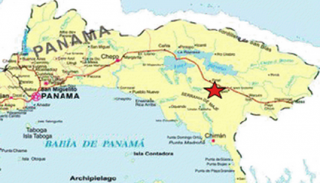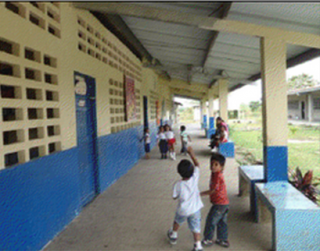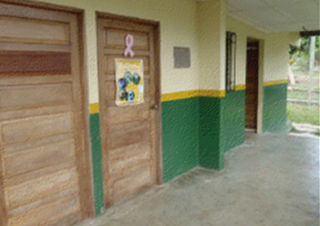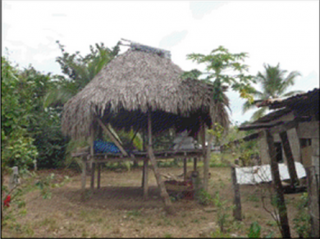Piriati Embera, Panama
![]()
![]()
![]()
![]()
![]()
![]()
![]() Click on Programs to learn more about their work in this community
Click on Programs to learn more about their work in this community
General Information

| Population* | 780 |
| Number of homes | 165 |
| Avg # of people per home | 5-6 |
| Number and % of children |
(0-5): 16.4% (0-12): 25.8% |
| Electricity | Yes (in parts) |
| Corregimiento | Torti |
| District | Chepo |
| Corresponding Health Center | Puesto de Salud |
| Distance from compounds | 30 minutes |
| Road conditions | Excellent |
* Population does not reflect how many patients will be seen on medical
brigades as many people from surrounding communities come seeking
Medical Brigades medical attention.
Top Needs Expressed
The top needs expressed by the key community members are water and health infrastructure, education, improvements to the school, waste management, and electricity.

| Piriati Embera's educational system includes Kinder, Primary and Middle schools (until 8th grade). There are about 160 students and Maria Camaño is the school director. Approximately, 85% of the community knows how to read and write. For further education, the students are able to access Torti's high school, which is about 30 minutes away by bus. MEDUCA (Ministry of Education), began construction on an extension of the school and it has not been completed for 2 years. |
Piriati Embera has a water system, which is a gravity-based aqueduct and was constructed in 2005. Water arrives on average 5 days per week and it is currently not being chlorinated. The water committee has six members, they meet every two months and the president is Ramiro Olea. The major problem is that the community is more spread out and every house does not have consistent access to water. There are also difficulties to the water pressure and altitude which causes the available amount of water to fluctuate during rainy season. Almost 100% of homes in the community are connected to the system and about 20 have water filters installed.

|
Piriati Embera has a Puesto de Salud (Health Facility), which is managed by the Assistant Health Worker, Deyanira Salazar. It has the basic medication needed for common sickness in the community, but does not have any medical equipment. The closest Centro de Salud is in the town of Torti, which is 30 minutes away by bus. There is no basic sanitation committee in the community.
The most common illnesses seen by community members are intestinal parasites, diarrhea, common cold and skin infections. Approximately 90% of the community is estimated to have latrines that currently function and about 25 homes have compost latrines. 0-10% has eco-stoves (estufas justas). About 20% is estimated to have cement floors, due to the fact that in traditional indigenous architecture the floors are made of wood. |

| The average family income per month is estimated to be $75-150 a month. The majority of homes are made of wood and sticks, following the traditional indigenous Emberá architecture. The main source of income comes from agriculture. The main products that are cultivated in the community are corn, rice, yam, yucca, grain, and plantains. The community also sells artisan goods. Members of the Piriati Embera do not have access to loans from the Savings and Loan Torti Cooperative because they do not own their land. Indigenous communities live on collective land. Approximately, 0-5% are members of the Cooperative, but do not have loans. By 2011, Piriati Embera had 5 kiosks, which sell dry goods, and 1 artisan shop. |
In Piriati Embera, the central method of waste management is burning trash or throwing it in the river. A truck drives through the community once a month to collect recycled goods (mainly aluminum and tin); however, approximately 5% of the community actually recycles their goods. The community has an estimated 50% of forest coverage and the main causes of deforestation are cattle ranching and farming. The Embera Congress has conducted a workshop on climate change in the past. The community is knowledgeable of environmental needs and is working to build awareness in the community.

| The Embera communities have access to an indigenous lawyer who lives in Chepo, an hour away by bus, however no one has worked with him yet. Most community members in Piriati Embera do not seek out legal support as lawyers are too expensive to afford. There is a limited amount of knowledge regarding the need for lawyers and their legal rights. The community members do not have land titles because they live on collective land. Common legal conflicts that occur in the community are related to land and family. |
Piriati Embera has not received a regular "brigade" from the Ministry of Health (MINSA) , for approximately one to two years (before 2011). The Peace Corps worked in Piriati Embera and helped with the installation of compost latrines and related education. Government organizations such as the Agropecurian Ministry (MIDA) and the Ministry of Social Development (MIDES) have begun smaller scale projects in the past; however, they were never completed.
Global Brigades met with community leaders and interested members in March 2011 and started brigades in May 2011 with the Medical and Environmental brigade programs. The Cacique is Guillermo Ramirez and he has shown dedication to helping his community move forward, especially in terms of environmental awareness.
Piriati Embera has been selected as a priority community by Global Brigades for future implementation of holistic programming.
Source of information: Key informant interview
Date of interview: March 1, 2011
Last Visited: February 13, 2014